Why Your Audience Left You (And How to Win Them Back)

1. The Power of Sustained Impression (Or: Stop Passing Out at First Dates)
Let me tell you about a date who passed out after one glass of wine. Was I concerned? A little. Did I call 911? No. I gave it a solid two minutes before assuming he was just bad at being outside and moved on.
This is exactly what brands forget. Your first impression matters, but so does the one after that. According to Harvard Business Review, acquiring a new customer is anywhere from 5 to 25 times more expensive than retaining an existing one. Think of it like that fine dining experience – you can’t just nail the amuse-bouche and then serve Hot Pockets for the main course.
How to Win Them Back:
- Create a consistent journey of discovery – The Met does this brilliantly with their rotating exhibitions that ensure there’s always something new to see.
- Maintain quality across every touchpoint – Like The Ritz-Carlton, where even the bathroom attendants have interesting stories to tell.
- Build anticipation through thoughtful programming – Think Beyoncé’s Renaissance tour rollout – now that’s how you build hype.
- Invest in the everyday experiences, not just the special occasions – Consider how Disney ensures that even waiting in line feels magical.
Let’s have a heart-to-heart about your brand’s relationship status.
Every brand experiences that moment when the magic starts to fade. Like a beloved restaurant that slowly loses its regulars, or a cultural institution watching its membership decline, the signs are subtle at first. The enthusiastic comments dwindle. The event RSVPs decrease. The social shares become sparse. According to a recent study by McKinsey, 71% of consumers expect companies to deliver personalized interactions, and 76% get frustrated when this doesn’t happen. Think of it as your audience quietly unfollowing you – in real life.
As your brand therapist (yes, that’s a thing now), I’ve spent years helping organizations transform their audience relationships. And let me tell you, I’ve seen some cases that would make a marriage counselor blush.
Consider these recent brand breakups:
- Peloton’s “perfect relationship” with pandemic-era fitness enthusiasts (turns out people actually like leaving their houses)
- WeWork’s “it’s complicated” status with the entire concept of office space
- Netflix’s dramatic falling out with password-sharing subscribers (though they’re reportedly working things out)
Let’s explore how to rediscover that connection and bring your audience back, with insights drawn from both data and what I like to call “brand couple’s therapy.”
2. The Art of Sustained Presence (Or: Stop Being That Flaky Friend)
Cultural brands often fall into the trap of showing up only for the big moments – the galas, the openings, the festivals. According to Sprout Social, 64% of consumers want brands to connect with them. Yet many brands treat their audience like that friend who only calls when they need help moving.
Take the cautionary tale of one hotel (which shall remain nameless to protect the guilty) that only engaged with guests during bookings and stays. Meanwhile, Four Seasons creates ongoing moments of delight: personalized local recommendations, social media engagement, and even a magazine that’s actually worth reading (shocking, I know).
How to Win Them Back:
- Develop a content strategy that provides value between major events – Like how The Wing created a whole lifestyle content ecosystem before… well, you know.
- Create meaningful micro-interactions – The way Glossier responds to literally every Instagram comment like a supportive best friend.
- Use technology thoughtfully to enhance, not replace, personal connection – Looking at you, every chatbot that’s ever asked “How can I help you today?”
- Build community through shared experiences – Think SoulCycle before they became… current SoulCycle.
3. The Balance of Innovation and Identity (Or: Don’t Get Stuck in the Safe Zone)
Like that “perfect” guy I almost married until three weeks in India made me realize I couldn’t live without actual passion, sometimes the safest choice isn’t the right one. The most compelling brands in the arts and culture understand how to evolve while maintaining their essence. Like a chef who honors traditional techniques while introducing contemporary elements, successful brands find ways to surprise without alienating. It’s the difference between Gucci’s Alessandro Michele-era renaissance and whatever Gap has been trying to do for the past decade: building on a legacy versus muddling it.
How to Win Them Back:
- Introduce new elements that complement your core identity – Think Tiffany & Co. collaborating with Supreme – weird but it worked.
- Create unexpected collaborations that make sense for your brand – Like when The Louvre let Beyoncé and Jay-Z basically take over the place.
- Take calculated risks that respect your audience’s sophistication – The way Loewe turned vegetables into luxury handbags and everyone somehow agreed this was genius.
- Use data to inform, but not dictate, creative decisions – Nobody asked for Balenciaga’s platform Crocs, but here we are.
4. When You Mess Up (Or: The Accidental 1:30 AM Call)
Speaking of awkward situations – I once accidentally butt-dialed my newest client at 1:30 a.m., thinking I was calling my boyfriend (same name—truly tragic). I then proceeded to beg him to pick me up from the bar like some damsel in distress. Brands, if you screw up, don’t try to spin it—just fix it. Sometimes your mistakes teach you exactly what needs to change.
In today’s landscape, digital engagement isn’t optional – it’s essential. But too many brands treat their digital presence like that neglected houseplant you keep meaning to water. You know the one.
Consider these success stories of brands that took smart risks:
- The Museum of Ice Cream turning dessert into an Instagram phenomenon
- Ace Hotel making lobby culture actually cool
- Stanley cups becoming the unexpected status symbol of 2024 (who saw that coming?)
How to Win Them Back:
- Challenge category conventions – Like how Sketch London turned afternoon tea into a pink-hued fever dream.
- Find your unique voice – The way Liquid Death made water metal.
- Create moments worth talking about – Remember when Emily in Paris made the Louvre cool again? The Louvre. Cool. Think about that.
Final Thoughts: Rekindling the Connection
Winning back your audience isn’t about grand gestures or complete reinvention. It’s about understanding what made them fall in love with you in the first place, then building upon that foundation with consistency, creativity, and care. Need inspiration? Check out our work with brands who’ve successfully navigated these transitions.
The most successful arts and cultural brands:
- Maintain excellence across all touchpoints (even their out-of-office emails are on brand)
- Create ongoing opportunities for connection (without being clingy)
- Balance tradition with thoughtful innovation (like a DJ at the opera, but make it fashion)
- Treat every interaction as an opportunity to deepen the relationship (but in a cool way, not a desperate one)
Remember: Your audience wants to stay connected. They’re looking for brands that understand their desires for both consistency and discovery, tradition and innovation, luxury and meaning. They’re not asking for perfection – they’re asking for presence, personality, and the occasional pleasant surprise.
Your next chapter starts with recognizing where the connection faded – and taking intentional steps to reignite it. And unlike my attempts at sourdough starter during lockdown, this is one relationship worth saving.
Now, shall we schedule another session?
More Blog Posts

Let’s be real—communication at work is kind of like a group chat. Some people over-share, some barely respond, and others...

Once upon a time, PR meant faxing a press release and hoping someone, somewhere, had paper in their machine. All...

Employee Appreciation Day, recognized on the first Friday in March, will be celebrated this year on March 7. It is...

We’re living in the age of data. Every swipe, click, and “add to cart” generates a treasure trove of information....

